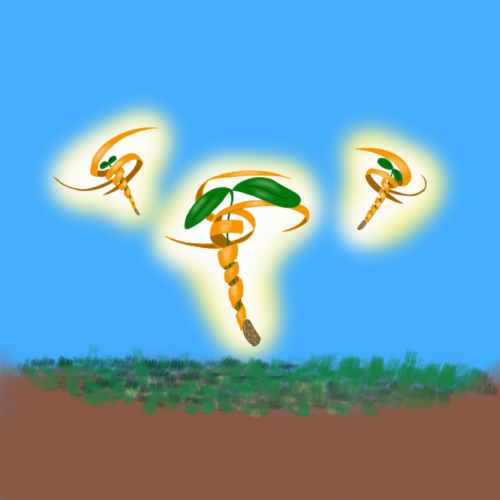Art Courtesy of Kara Tao
Look, up in the sky! It’s a bird! It’s a plane! It’s… hundreds of autonomous self-burying seed carriers? These small wooden contraptions are built with a unique design that lets them bury a seed into the ground after dropping from a great height. While unlikely to drop into your backyard, this new invention spearheaded by Lining Yao of Carnegie Mellon University and Teng Zhang of Syracuse University could change the face of reforestation via air. The design for these carriers is inspired by Eroidium seeds, and they are made using natural materials such as wood. The carriers provide a nature-based solution to our man-made problems regarding habitat loss, forest shrinkage, and even agricultural complications.
Aerial seeding—when seeds are scattered by plane, drone, or helicopter—is an invaluable technique when it comes to wildland restoration, reforestation, and agriculture, especially for large swaths of hard-to-access land. However, the scattered seeds often fail to penetrate the ground. This dramatically decreases their chances of germination, as they can get eaten by wildlife or swept away by harsh weather conditions.
The device is closely modeled on the seeds of Erodium, a flowering plant that has seeds with a special design: a coiled body and single twisting tail that allows them to bury into the soil. “It’s very hard to reproduce the performance and also the biodegradable nature of the Erodium seeds,” Zhang said.
After many rounds of testing, the final design has a twist: three tails instead of one. “These three points provide a stable contact between the structure and the soil,” Zhang said. To picture the device, imagine a propeller with three blades circling each other on top—these are the three tails. In the center, where the three tails meet, a coil extends downward in a straight line—this is the coil body. At the end of the coil body lies the seed tip, where the seed is stored. In addition to the three tails, the other main innovation is the coil, which provides the mechanical force to allow the carriers to drill into the ground. The researchers treated the wood used to make the coil body with multiple rounds of chemical treatment and mechanical deformation in order to create its twisting shape.
The carrier is rain-driven—another concept borrowed from Erodium seeds, which change shape depending on humidity. The wood cells in the coil swell during rainfall, with those on the inside swelling more than those on the outside, causing the coil to unwind and the seed to be drilled into the ground. As the coil dries, the cells on the inside shrink more than those on the outside, promoting another coiling mechanism in the opposite direction that further embeds the seed.
The main challenges faced by the researchers included field tests that could be done best only in the spring, resulting in months of wait time until conditions were suitable, in addition to day-of weather concerns. Furthermore, the researchers created a simulation to test the device’s performance which proved difficult, considering friction and the many connections between the tails and coil body.
The carriers have a few issues: they can be negatively affected by extreme weather conditions, the tip-coil connection can sometimes break, and the tails can tangle during release. The team aims to fix these issues as well as test other types of materials. The tested carriers were made of white oak, but other woods or materials could potentially be used with the design. Having a larger material library will enhance the feasibility of production in different regions. Additionally, the researchers are exploring other dimensions for the seed carriers that could improve their performance.
Currently, the carriers are lovingly crafted by hand—which is not a production method that can continue long-term. The team is now focusing on producing on an industrial scale. “The cost [of production] is really about the time and the effort. The material cost is relatively cheap,” Zhang said.
Yao, Zhang, and their team are currently seeking partners and stakeholders to expand their impact. “Responsive and functional structures that are powered by renewable energy could play a critical role in natural contexts, for ecological purposes such as restorations and environmental monitoring,” Yao said.
When faced with a problem, sometimes the best inspiration is to look to nature. That has certainly proved to be the case with these self-drilling seed carriers. And in ten years’ time, maybe the future of our world’s forests will be saved by a swarm of plucky, three-tailed robots falling from the sky.

